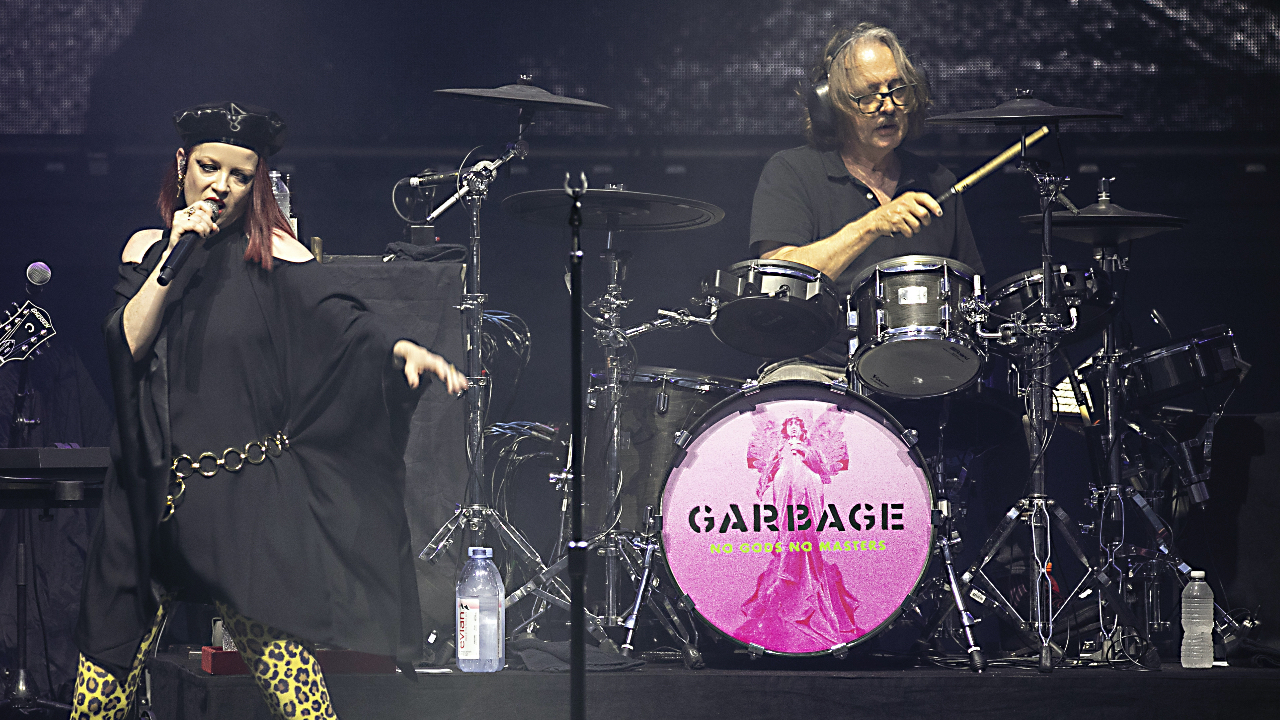Butch Vig on playing Roland V-Drums live with Garbage: "I jumped at the chance!"
The producer and drummer recently spoke to Sweetwater about why a fully-electronic VAD drum kit is his go-to setup

We know him best as the man behind the glass for Nirvana, Smashing Pumpkins, Green Day, Foo Fighters and more, but Butch Vig not only happens to be a successful drummer in his own right as a founding member of Garbage, but has been playing electronic drum sets and ‘hybrid drums’ since long before the term was coined.
In a recent chat with Sweetwater’s Nick D’Virgilio (another masterful drummer), Butch talks electronic turkey and the evolution of his journey using hybrid gear. The video, titled ‘Butch Vig on Why You Should Tour With an Electronic Drum Kit’ is full of insights into the pros of switching to a fully-electronic kit. Here are a few things we learnt.
It’s a lot easier and better than it used to be!
This isn’t about how fortunate we are to exist at this specific moment in time. But let’s face it, we are. In two decades we’ll be wondering how we got by without AI-generated, perfect sounds that magically appear via iThought™ neuro-links beamed straight to our drum modules (we probably won’t be using modules). Hell, we’ll probably begrudge the fact we even have to plug in a cable (we probably won’t need to do that, either).
The point is, in 2023 it’s more than perfectly conceivable to play a gig on an entirely electronic drum set, and if you’re ever worried that your kit might not sound ‘like real drums’, Butch’s ’90s experience with electronics is a reminder of how far things have come.
“It was tricky when we started out in Garbage” admits Butch when asked about his early days with electronics. “Because we wanted to bring the sound of the records that we’d done in the studio to [the live shows] and didn’t even really understand how to do that initially.”
“We bought a ddrum trigger and I started loading-in 8-bit, mono samples that I could trigger from the acoustic kit. It was kind of a mess, the ddrum triggered fast, but it just didn’t sound that great…It was kind of crunchy sounding, but that’s all we really had that worked at the time.”
Your band (and ears) will thank you for it
We’ve all come up against a venue’s noise limiter before. We’ve probably all, at some point been the butt of the old ‘Does the drummer have a volume control?!’ joke too. Electronic drum remove the problems that come ever-increasingly in smaller venues, and it’s not just over-sensitive venue owners or audiences, either. Sometimes we’re too loud for our bandmates. Electronic kits could mean you never have to hear ‘Can you play the cajon?’ again.
Want all the hottest music and gear news, reviews, deals, features and more, direct to your inbox? Sign up here.
“Roland approached me in 2016 about playing a TD-50X and I jumped at the chance…We started using it in the first rehearsals and the band loved it…especially Shirley [Manson] because she sings very dynamically.
“I used to put up plexiglass around the [acoustic] cymbals to keep them from going into her mic. The bummer about that was the plexi aimed the cymbals right back at my head. But we got rid of all that with the Roland TD-50X. Our stage is absolutely dead-quiet. Shirley is the only mic on stage and we all use in-ears.”

The magic is in the tweaking
So, you’ve bought your electronic drum set - just plug it in and away you go, right? Wrong. Just as your acoustic setup needs tuning and dampening, or your cymbal selection will reflect the style of music or venue you’re playing in, your electronic sounds will require adjustment.
This can take time and will require you to get to know your module and settings, but refine it properly and you’ll be reaping the benefits and flexibility in no time.
“When I build a kit, I start with one of the stock Roland kits. I’ll go through and tweak every single thing." Says Butch. "I’ll find the particular hi-hat I want, I find the snare and I might add some snare strainer. I’ll compress and EQ it, mess with the tuning…
“I work on that and I get it really well balanced before I start adding any samples in. In my TD-50X I have about 150 samples from Garbage records. If it’s a song like Stupid Girl, say, I know there’s a specific kick that I want to use.
“I’ll layer that with the [Roland kick] and then instead of bringing it up to zero, it’s maybe back 5 or 6 dB. Same with the snare…I don’t layer on the hi-hat. Occasionally I’ll layer cymbals, like on the ride if I’m doing a lot of heavy, Ringo-style washing, I’ll be able to get a clear ping and then I’ll layer a crash underneath it.”
Keeping things organised helps
With our acoustic kits, we know what each drum or cymbal is going to sound like. The rack tom will always be a rack tom, the 10” splash will never become a handclap. The same can’t be said for electronic drums, and while this is obviously a massive part of the appeal, it can also be a quick way of losing your bearings.
Butch keeps his pads assigned in zones, placing the same types of sounds on consistent pads. “I also have samples that are sound effects, drum loops, sometimes I have these crazy, distorted sequenced drum fills that I’ll trigger…those are on the aux pads.
"I usually have a kick/snare/rack/floor setup, then I have a pad to my left which is an alt-snare that I use in a lot of breakdown sections. Then I have two pads to the left and right of my rack tom, and those are more for sound effects.”
It’s a sound engineer’s dream
Removing sympathetic snare buzz, floor tom growls or beachball bass drum rings? Not necessary with electronics. If you’re lucky enough to have a dedicated engineer - or even if it’s yourself or one of your bandmates - Butch Vig says that using a fully-electronic setup can eliminate some of the headaches of mic’ing and mixing an acoustic kit.
“Our front-of-house guy, Dave Gaume loves [the electronic drums] because from night to night, I turn on the TD-50X and the kit is exactly the same as it was the night before. He knows there’s a preset for every song and it’s going to sound exactly like he had them, so it’s pretty cool.”
Monitoring is key
Monitoring is usually more of a requirement for us drummers to hear the rest of the band, but with an electronic setup our drum sound is confined to the outputs of our module. Therefore, a good set of in-ear monitors (or drummer-friendly headphones like Butch uses) is crucial for us and our bandmates to not only hear the kit, but to be able to play naturally too.
“Obviously, if you’re playing an acoustic kit, musicians are used to that. They hear the sound coming up around them, and when that’s gone you have to rely on a headphone mix. It’s very imperative - I tell this to a lot of people when they ask me about using the TD-50X: you have to get a really good headphone mix.
“Otherwise you’re going to miss that kind of feel from the acoustic drums. You’re just used to all the overtones from the cymbals and stuff, but when you get a really good mix in your headphones, it’s awesome. I feel like I respond to the drums with the same dynamics [as acoustic drums] once I have my mix dialled in.

Use your outputs
Intermediate and pro-level modules have greater connectivity than a stereo output or headphone socket, and making use of your module’s direct outputs correctly can have massive benefits to your overall sound.
By routing individual drums, or grouping sonically similar parts of your kit to their own outputs, you can send a completely tailored set of component sounds to the PA. This allows them to be processed and mixed by the person who is actually hearing what the audience hears, just as your acoustic drum microphones would be.
“It’s the same for the front-of-house. Dave has to really make sure he’s got a blend between the [virtual] overheads and the hi-hat and the sound effects. Sometimes if it’s a drier outdoor venue with not a lot of ambience he’ll add a little extra reverb.
“Some venues are really boomy, in which case he likes that I can make the drums really dry so they can cut through the mix. That’s kind of a show-by-show decision that he makes every night.
"The only thing that’s sub-mixed together are the cymbals - the crashes and the ride are mixed to a stereo out. But everything else is just a direct output that goes straight to the console.”

Stuart has been working for guitar publications since 2008, beginning his career as Reviews Editor for Total Guitar before becoming Editor for six years. During this time, he and the team brought the magazine into the modern age with digital editions, a Youtube channel and the Apple chart-bothering Total Guitar Podcast. Stuart has also served as a freelance writer for Guitar World, Guitarist and MusicRadar reviewing hundreds of products spanning everything from acoustic guitars to valve amps, modelers and plugins. When not spouting his opinions on the best new gear, Stuart has been reminded on many occasions that the 'never meet your heroes' rule is entirely wrong, clocking-up interviews with the likes of Eddie Van Halen, Foo Fighters, Green Day and many, many more.